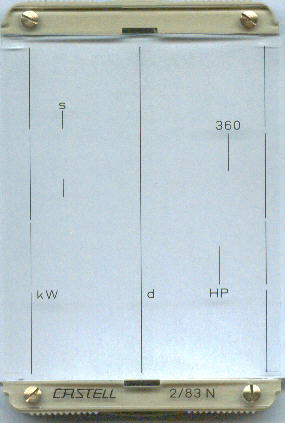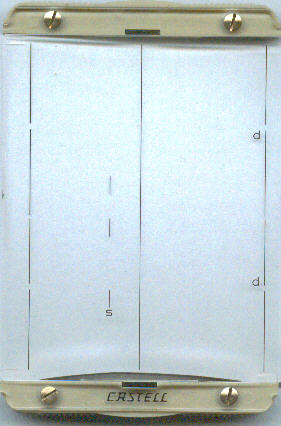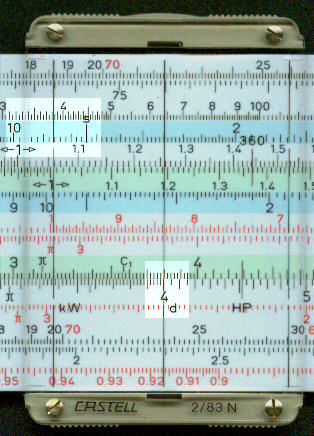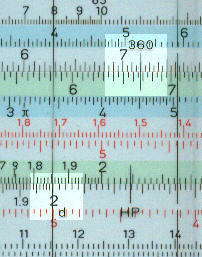

| Slide rules HOME page | INSTRUCTIONS | A-to-Z |
Cursor
The main purpose of the cursor is to enable the the correct alignment of different parts of the slide rule which are not immediately adjacent. For this purpose a cursor has a central hairline, a fine line engraved on or set into the cursor. On duplex rules the cursor will also allow the alignment of scales on both faces of the rule. On some rules the cursor extends over the edges of the rules allowing scale to be placed there.
The cursor may be of glass or plastic. In the case of glass cursors, the cursor is set into a metal frame. The cursor has a small spring which fits into the grove of the stock and, whilst allowing the cursor to slide, helps to hold it in place. Early cursors were made entirely of metal and the alignment was with small "tongues" of metal.
In addition to the central hair-line, a cursor may have other hair-lines designed to facilitate frequently performed types of calculations. This type of cursor is more common on European rules than on ones from the USA.
| Nominal Value | True Value | Associated scale | Uses |
| .785 | .785 | A,B | p /4 |
| .886 | .8862 | C,D | Ö (p /4) |
| .736 | 736 | A,B | Watts per British horsepower |
| .746 | 746 | A,B | Watts per French horsepower |
| 1.128 | C,D,A,B | Same as gauge point c |
The two images below are from a Faber Castell 2/83N, a duplex rule with a complex multi-line cursor.


On both sides there is a long central hairline and two long hairlines near to the edge of the cursor. On this rule some of the scales are extended close to the end braces and the two extra hairlines are there to enable these scale extensions to be read.
The first example of the use of the cursor is to calculate the area of a circle. In the image below the diameter, 4, is set on the D scale against the "d" line on the cursor and the area, 12.6, is read against the "s" line on the cursor on the A scale. The cursor has a second "s" line for use with the C and B scales.

The next example shows the conversion from HP (horse-power) to kW (kilowatts). By setting the horsepower of 50 on the D scale against the HP line the equivalent number of kilowatts, 37 300 kW, can be read against the kW line also on the D scale.

The final example shows the use of the "360" hairline. This makes use of the fact that the upper scale on the slide (CF) and the adjacent scale on the stock (DF) are displaced relative to the C and D scales by a factor of p. The distance from the "360" line to the central line is, in effect 3.6/p. The example below shows a value of 2 m/s on the D a scale and the conversion to km/h, 7.2, on the DF scale.

| Return to | Basics in A-to-Z |